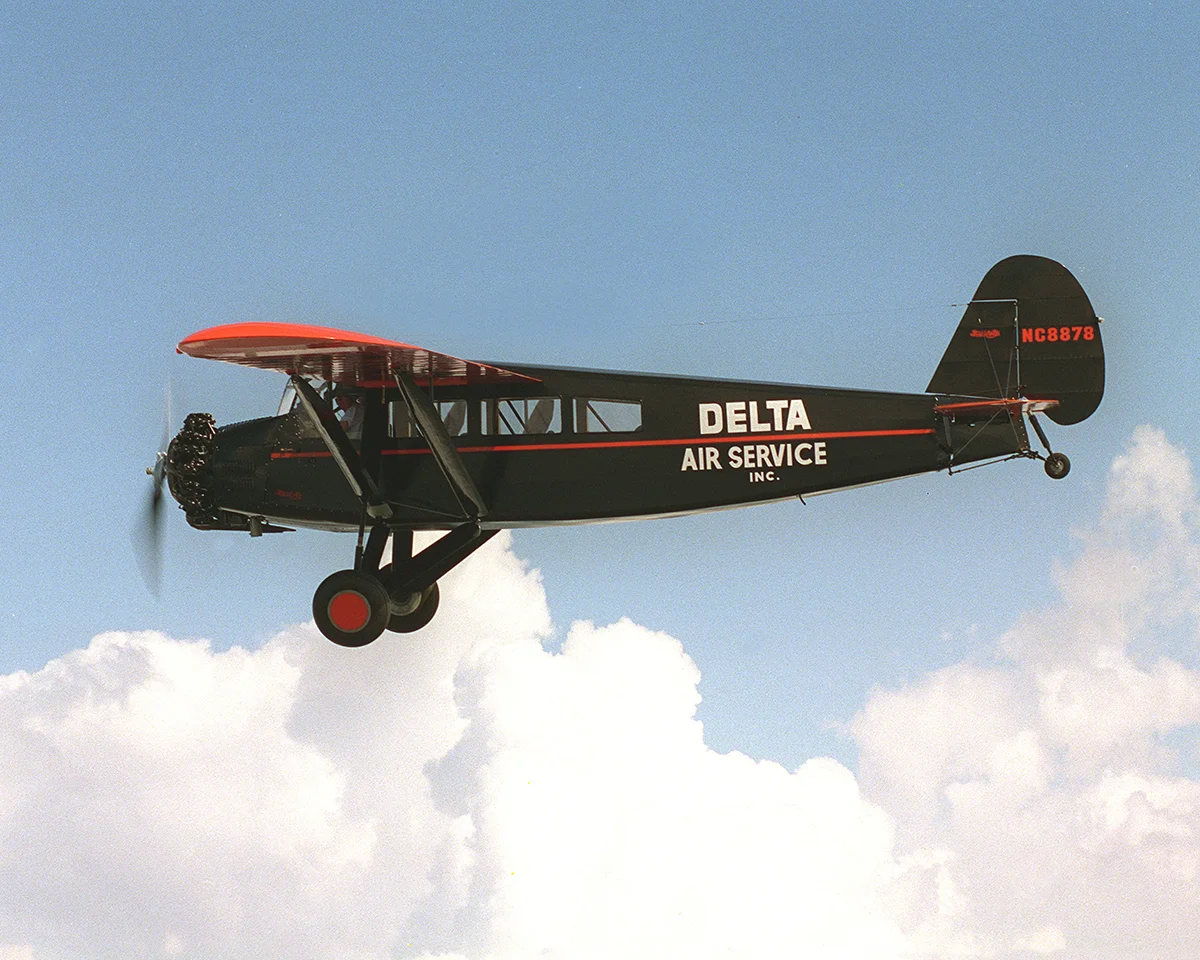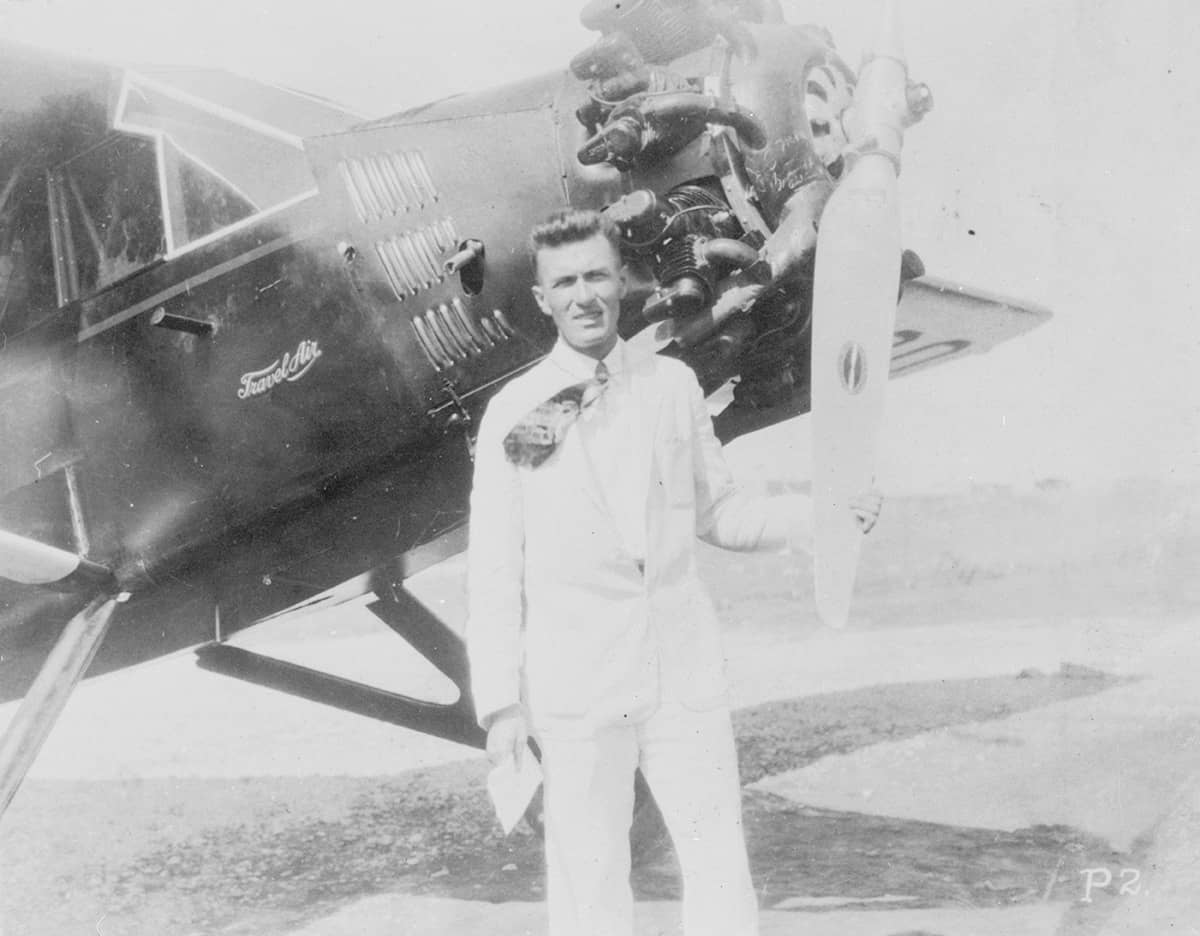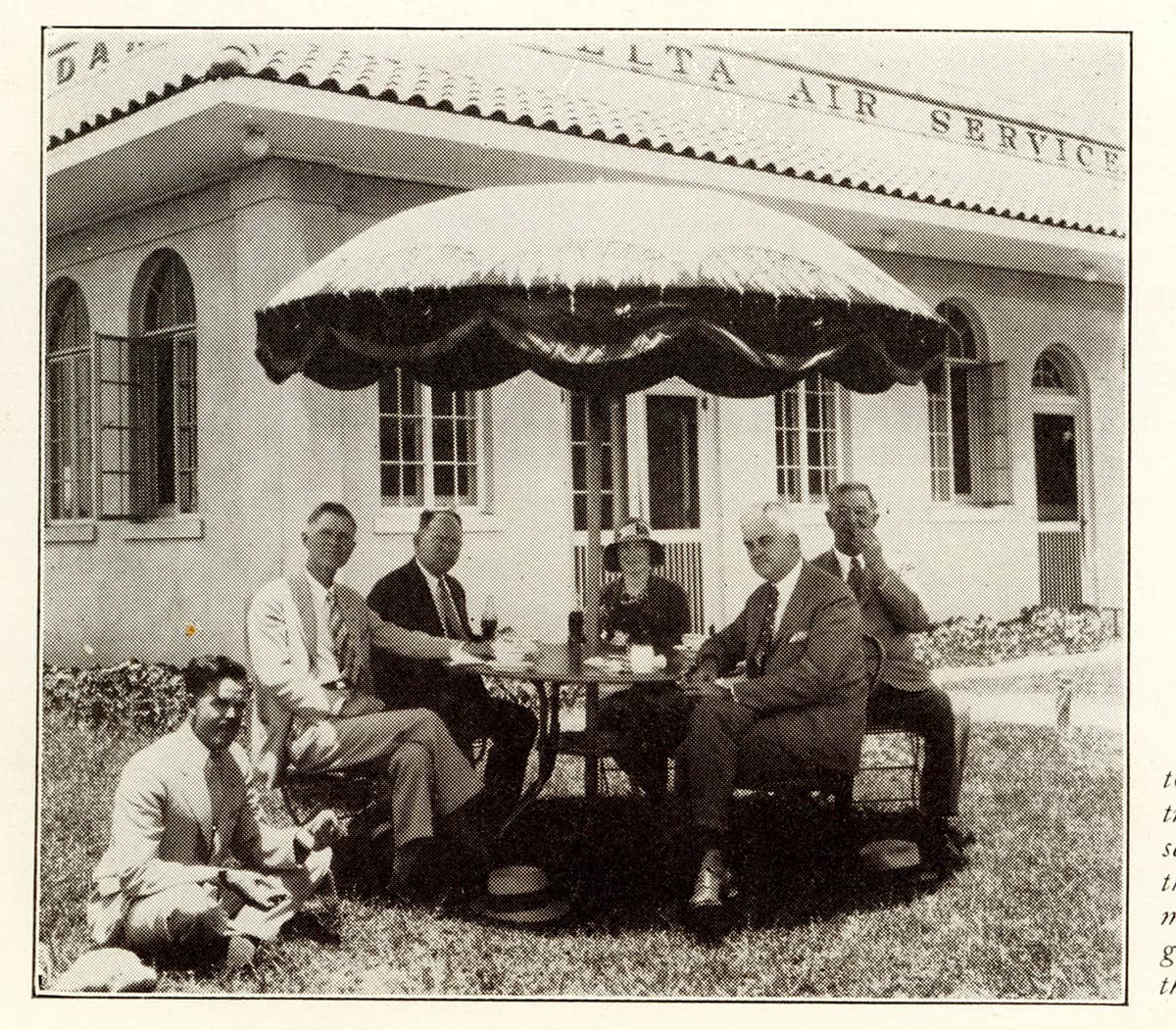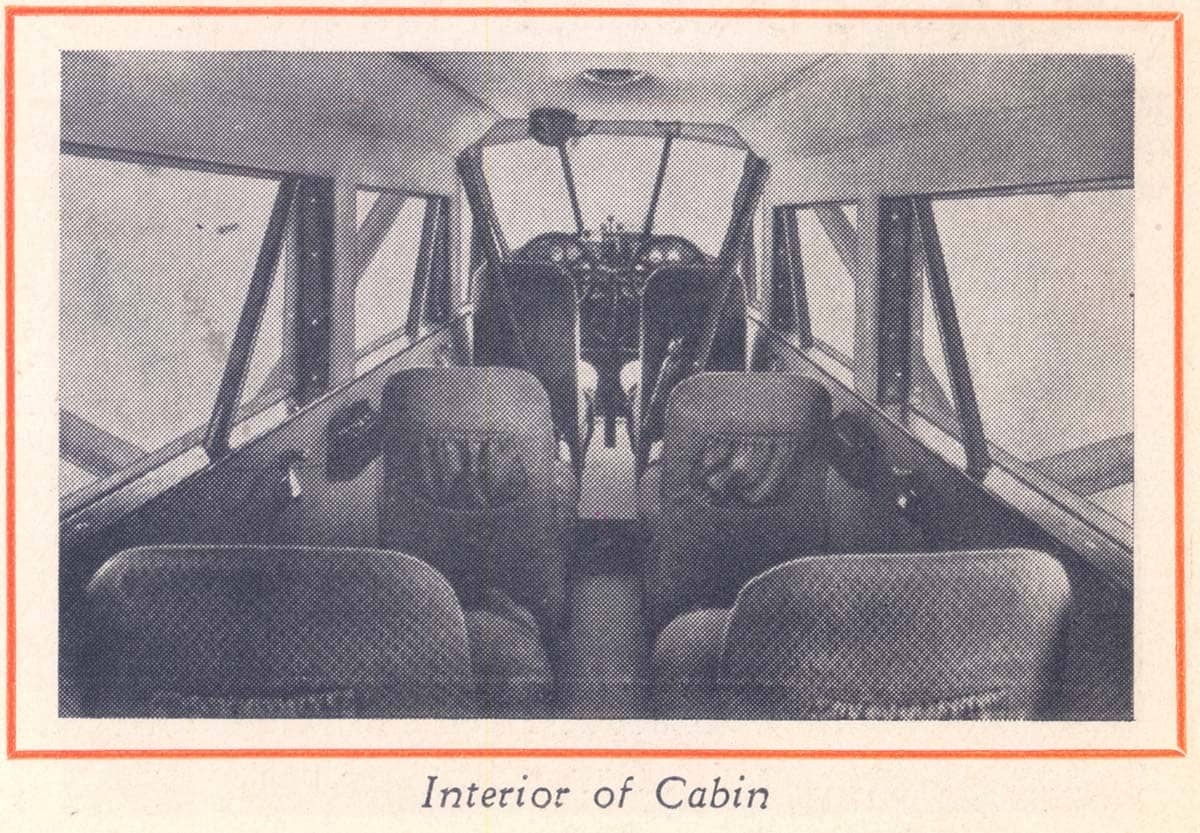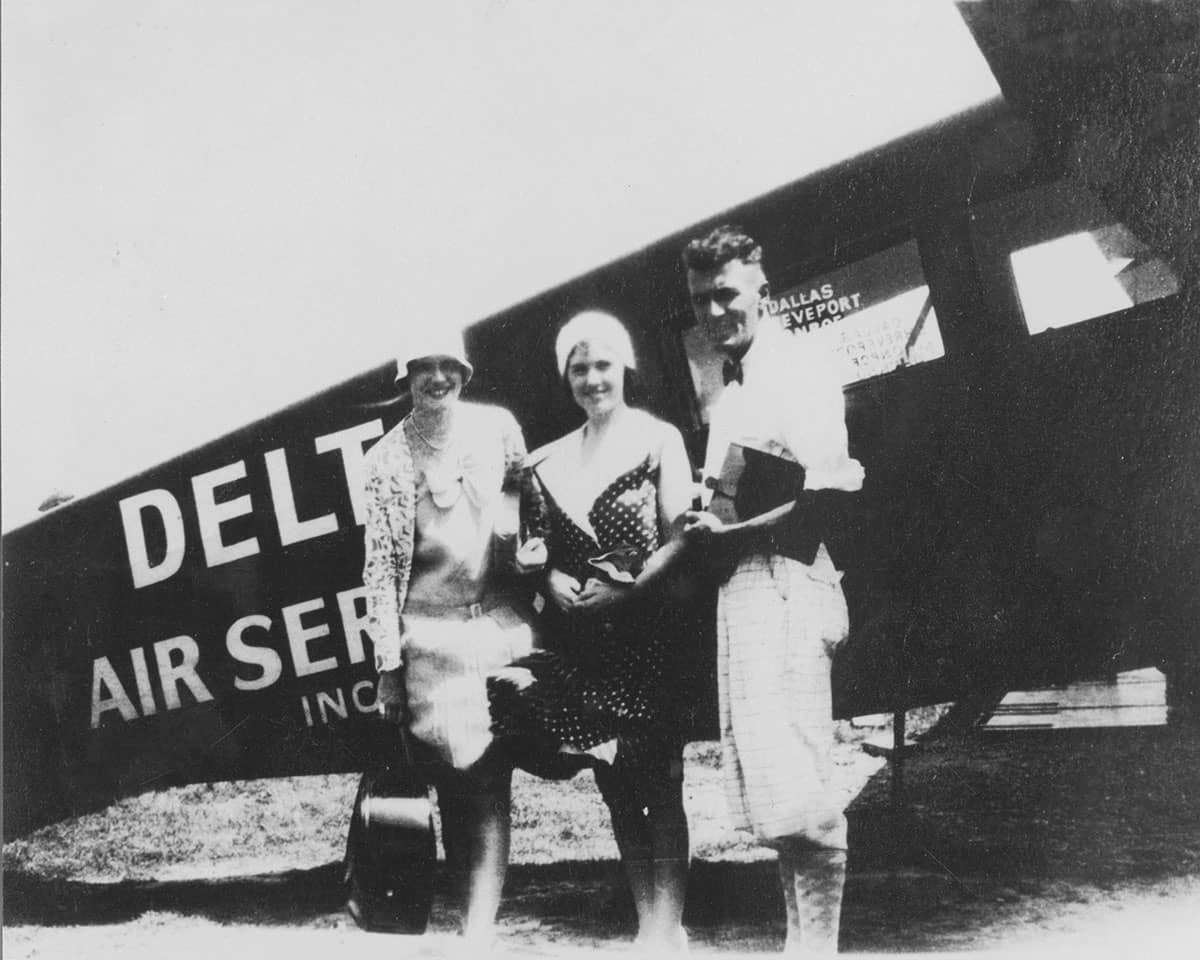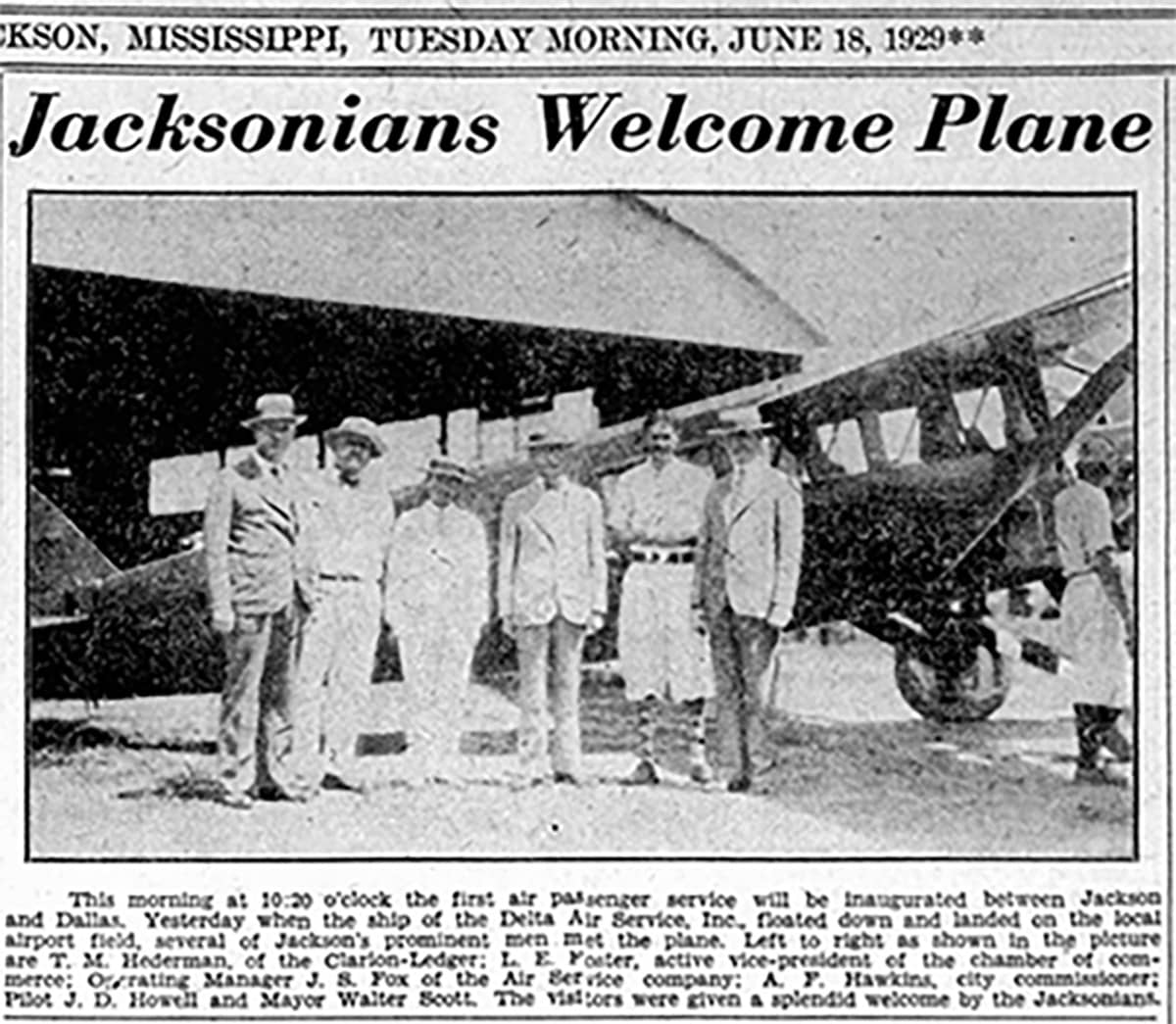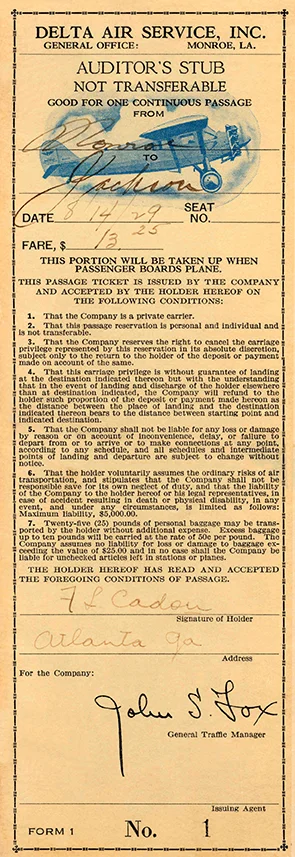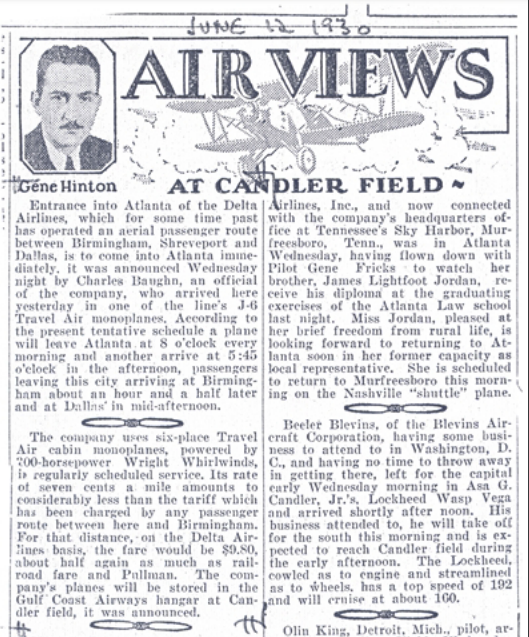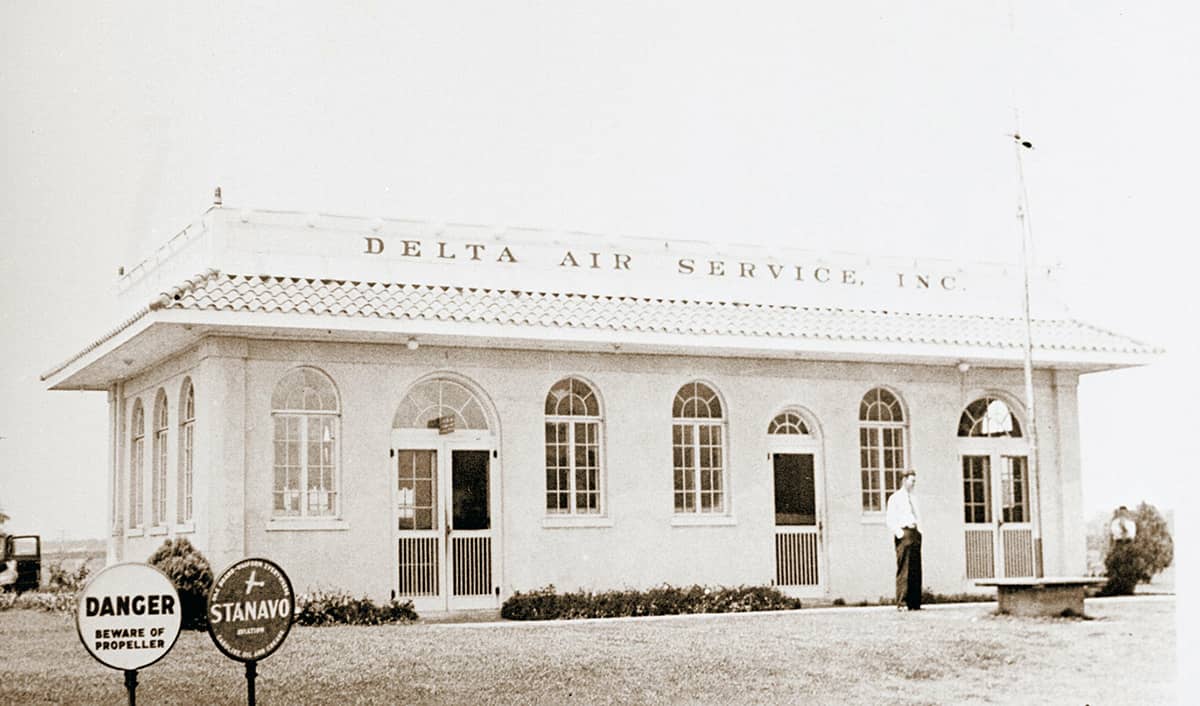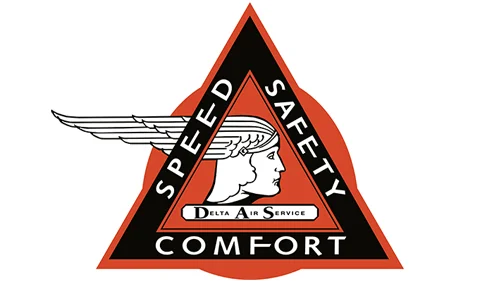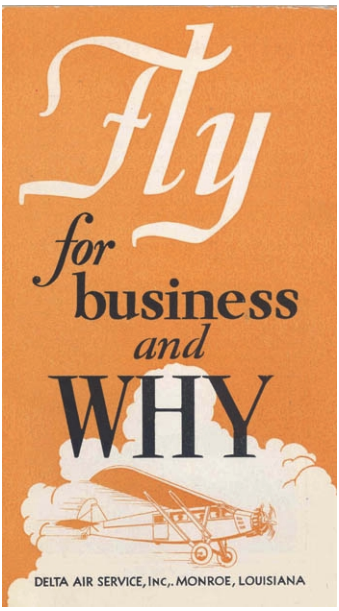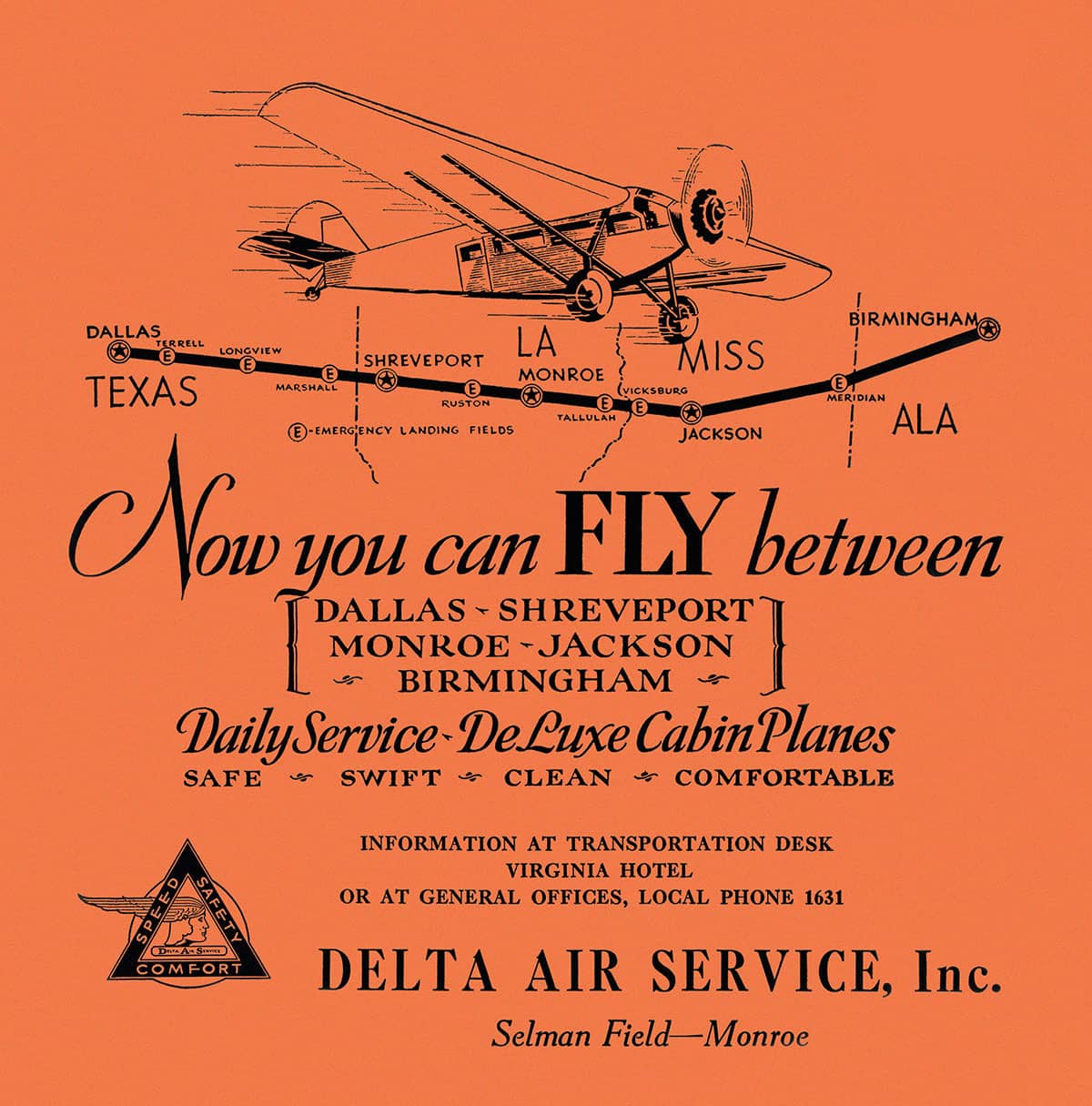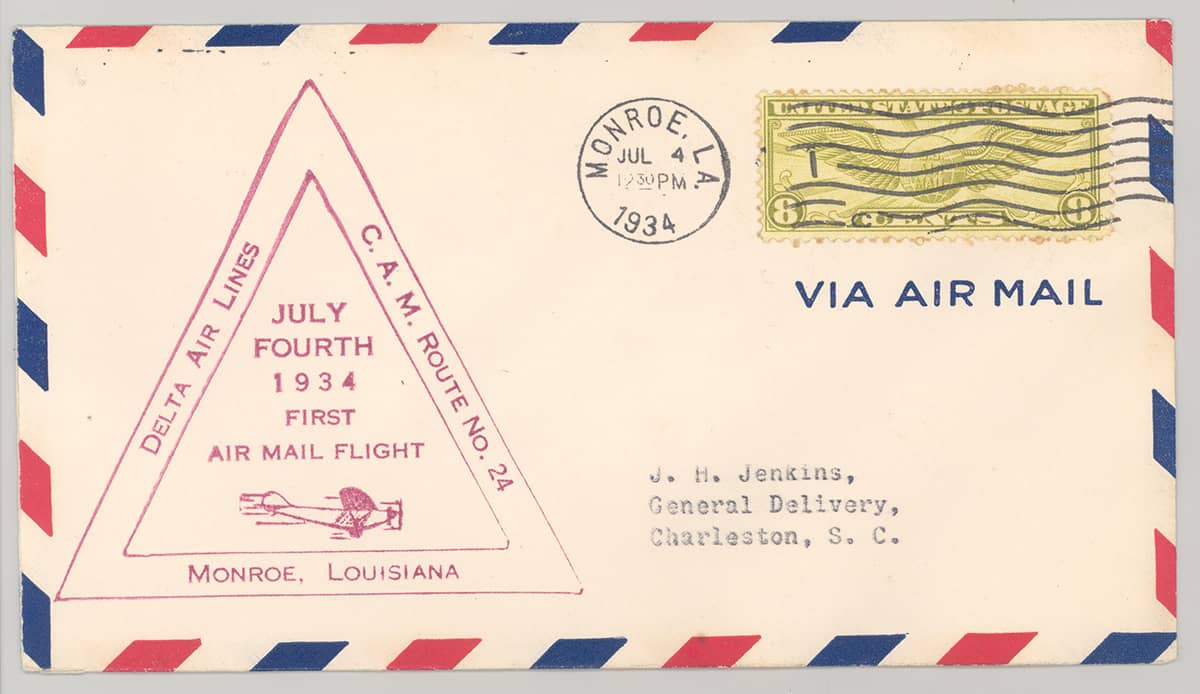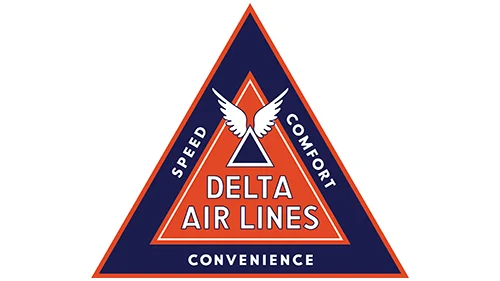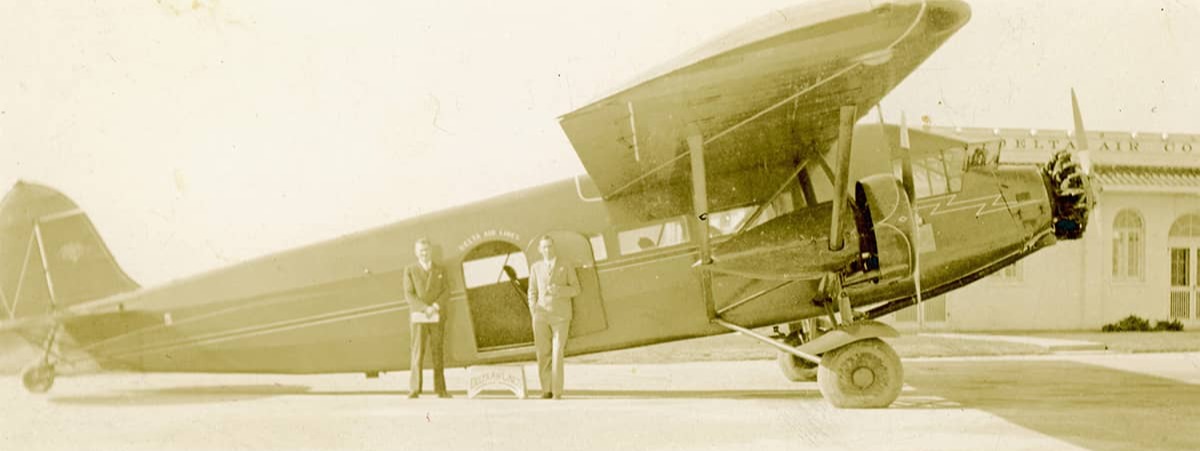
Travel Air S-6000-B, a single-engine plane with enclosed cabin. Capacity for one pilot and up to five passengers. A restored Travel Air on display at the Delta Flight Museum represents the Travel Air registered as C8878, manufacturer's serial number 988, which flew Delta's inaugural flight.
Departed Dallas, Texas, at 8 a.m. on Monday, June 17, 1929. Made scheduled stops at Shreveport and Monroe, Louisiana, before landing at Jackson, Mississippi. The 427-mile flight took 5 hours and included a half-hour stop for lunch in Monroe.
Delta pioneered this route. It was the first airline to offer air service between Dallas and Jackson.
J. D. "Johnny" Howe, a tall, lanky Arkansas airman with six years of flying experience. He previously worked as an agent for the Travel Air Company. Considered an excellent stunt flier, Howe was one of the first pilots in the nation to receive a commercial pilot's license.
John S. Fox, Delta Air Service operations manager.
No other passengers, as Delta did not publicly announce the new service until Sunday, June 16, when all facilities were equipped and ready. Rival interests were reported to be looking at flying from Atlanta, Georgia, and Birmingham, Alabama, over the same route to Dallas, and Delta moved quickly to launch service first and keep a competitive advantage. They also could not sell round-trip tickets, because they were picking up a group of Jackson officials on the last stop for the inaugural return flight to Dallas the next day.
Jackson Mayor Walter A. Scott and several other city officials welcomed Fox and Howe at the airfield when the inaugural flight arrived. Community leaders hosted them at a banquet later that evening.
Fares from Dallas to Jackson were $47.25 one-way, $90.00 round trip.
Tri-weekly service. Three eastbound flights on Mondays, Wednesdays and Fridays. Three westbound flights on Tuesdays, Thursdays and Saturdays.
Westbound flights departed later in the morning (10:20 a.m.) than eastbound flights, to allow a proposed extension of air service from Birmingham, Ala., and Atlanta.
For flight schedules from Fall/Winter 1929 to Summer 1930, see our Public Archives.
Travel Air S-6000-B, aircraft registration number C8878, serial number 988.
Departed Jackson, Miss., at 10:20 am on Tuesday, June 18, 1929. The plane made scheduled stops at Monroe and Shreveport, La., on its way to Dallas.
J. D. "Johnny" Howe
Inaugural guests, a group of Jackson officials:
- Paul Chambers, president of the Jackson Chamber of Commerce
- A.F. "Gus" Hawkins, Jackson city commissioner of Aeronautics
- L.E. Foster, executive vice president of the Jackson Chamber of Commerce
- John S. Fox, Delta Air Service operations manager
At Selman Field in Monroe, the group was welcomed by city, parish and chamber of commerce officials with lunch at improvised tables in the hangar. The Monroe News-Star reported that the Jackson party had traveled "as much as 125 miles an hour and that there was little vibration or unpleasant experiences. The view obtained, especially of the swollen waters of the Mississippi near Vicksburg, was commented on."
From Dallas, the Jackson officials sent this telegram: "First westward trip Delta Airways big success. Arrived at 3:40, twenty minutes ahead of schedule after four hours flying time. Had wonderful receptions at Monroe, Shreveport and Dallas. Believe the establishment of this line will mean much to Jackson in a commercial way. Had delightful trip, this being the only real way to travel."
W.C. (William Cyril) Walsh, a factory representative for Dodge Brothers motor cars, was Delta's first paying passenger. He traveled from Monroe to Jackson with the returning Jackson group.
The Jackson party departed Dallas for Monroe in the same Travel Air they arrived in the previous day (registration C8878) with pilot Johnny Howe. The Jackson Clarion-Ledger reported they flew mostly at an altitude of around 5,000 feet, "sailing above the clouds much of the time. For an interval, Pilot Howe flew through clouds to see how his passengers liked it. An air pocket caused a sudden drop of about 400 feet in one instance but the flight was uneventful, with fine weather."
John S. Fox, Delta Air Service operations manager, also flew from Dallas with the Jackson officials, but he left the flight in Monroe, where passenger W.C. Walsh was waiting, so there was room in the plane for Walsh to fly to Jackson.
For the Monroe-Jackson leg of the flight, the group changed planes. They left Monroe in a brand-new Travel Air S-6000-B aircraft, recently delivered from the Travel Air factory, flown by Chief Pilot Pat L. Higgins.
Higgins was originally hired to head Delta's Flying School in March 1929. He moved to Monroe from New Orleans where he had also managed an aviation school. Previously, he worked for the Curtiss aircraft manufacturer, barnstormed through the Southern states and flew in the military during World War I.
After less than three months, Delta extended its original route east from Jackson to Meridian, Miss., and Birmingham, Ala. on August 26, 1929. A 10-minute stop between those cities at Tuscaloosa, Ala. was announced on September 3, 1929.
Effective January 20, 1930, service increased to two daily flights except Sundays between Dallas and Monroe. Delta also made air travel more affordable and convenient for its customers. Fares were reduced by almost fifty percent, and Delta adjusted its schedule so arrivals and departures allowed passengers to connect with north-south rail service and overnight Pullman service.
April 1930 was a busy month for the growing airline. Service to Tyler, Texas, began on April 4, and on April 9, the western terminus of Delta's route extended from Dallas to Fort Worth. J.D. Greer, pilot of the inaugural eastward flight, carried a "handsomely decorated horseshoe" for good luck, presented by the Fort Worth Chamber of Commerce. Delta now offered daily service over its entire route and coordinated flights at Birmingham with Atlanta-based Davis Air Lines and at Dallas with Southern Air Transport to El Paso and from there to Los Angeles.
"Air distance between Atlanta and Los Angeles reduced to three days, without night travel," announced The Atlanta Constitution newspaper. "The distance from Atlanta to Dallas can be traveled between suns." A passenger could leave Atlanta by Davis Air Lines at 8:00 a.m.; arrive Birmingham, 9:30 a.m.; leave Birmingham by Delta Air Service at 9:35 a.m.; arrive Dallas at 5:10 p.m. From Dallas to Los Angeles, required two more days of travel and connecting flights.
Delta entered Atlanta on June 12, 1930. After a few days of trial runs, regular service began on June 18. For details and fares, see this Atlanta Journal newspaper item (see above) and timetable.
It's believed that Delta's first charter flight was on October 19, 1929. The Monroe News-Star newspaper reported that ten Monroe football fans and supporters of Louisiana State University chartered two Travel Air planes to carry them to and from Jackson, Miss. to watch LSU and Mississippi A&M play. Each plane carried a pilot and five passengers to the game. The Monroe-Jackson flight was expected to take one hour and 15 minutes.
Most of Delta's early customers were businessmen traveling for work. Pleasure and vacation air travel was not common. General Manager C.E. Woolman estimated, "Eighty percent of our patrons are men with briefcases, going about the country and speeding up their business."
Delta published a brochure full of encouragement for the nervous first-time business flier with details about services and a flight schedule. See the Fly for Business brochure (PDF).
Delta also placed advertisements in local newspapers and participated in air shows and other events promoting aviation. C.E. Woolman was "a terrific salesman," and developed good relationships in the communities Delta served and with local and federal government officials.
“Delta had no marketing department," retiree Wallace Harmon recalled. "In large cities we had a city traffic manager [in the mid-late 1930s]. . . who would go to the hotels and check the brochure racks to be sure that our timetables were there, and that was pretty well the extent of the marketing effort. Except that they would also make calls on the hotel porter because the porter was the guy that the hotel guests would call to get reservations on airlines. Now this is a holdover from the railroads. A few of the things that we did to begin with were holdovers from the railroad.”
After one year of passenger service, Delta had flown approximately 251,000 miles by June 1930, and operated its entire first year without an accident in an era when tragedy was not uncommon. Delta's General Manager C.E. Woolman said, "This record is accounted for by the factors of perfect servicing of ships, good pilots and every possible safeguard."
Although Delta's crop-dusting operations were profitable, the expenses of expanding passenger services—and the growing economic Great Depression—made it critical that Delta secure an air mail contract from the federal government. Delta had high hopes of winning a mail contract over the route it had pioneered, until the U.S. Post Office awarded a southern transcontinental air mail contract to American Airlines predecessor company, Aviation Corporation (AVCO). Part of this route was from Dallas to Atlanta, along Delta's only route.
Delta suspended airline operations in October 1930, and sold its Travel Airs. Reorganizing as Delta Air Corporation in December 1930, Delta was once again a crop-dusting company.
Looking back at Delta Air Service's 1929-1930 service, the Monroe News-Star noted "high compliments" from government officials and the aviation community for "the efficiency, economy, and safety features which marked the operation of the Delta line throughout its history as a passenger carrying agency."
In 1934, the U.S Post Office cancelled airmail contracts and submitted all routes for rebid. With a winning bid of 24.8 cents per pound of mail, Delta Air Corporation was awarded Air Mail Route 24, stretching from Ft. Worth, Texas, to Charleston, South Carolina.
On July 4, 1934, Delta started its first mail service with tri-motor Stinson Model T planes. Passenger service resumed on August 5. For the first time the name "Delta Air Lines" was painted on the sides of planes, and Delta begins doing business as Delta Air Lines.
As Delta's routes expanded northward in 1941, Delta's headquarters relocated from Monroe, La. to Atlanta. In 1945, Delta Air Corporation was officially renamed Delta Air Lines.
